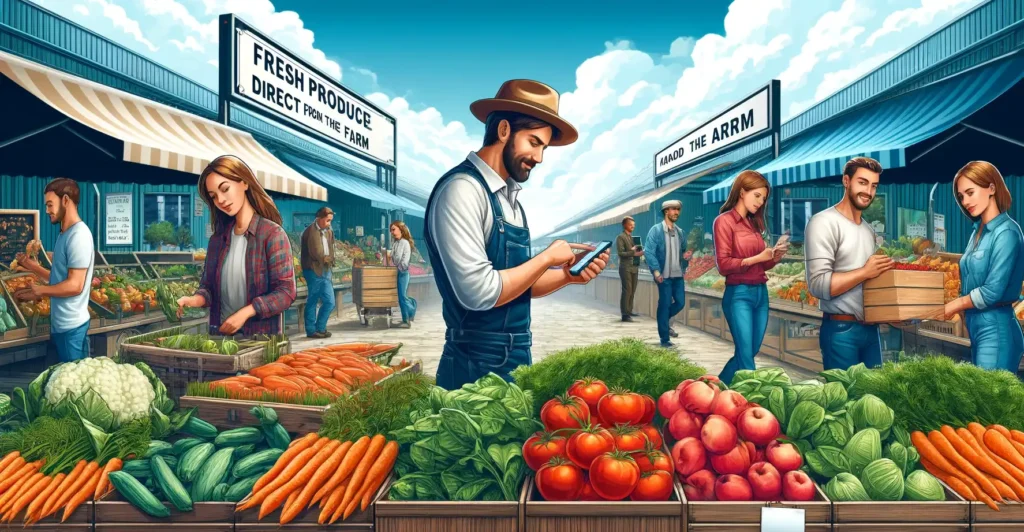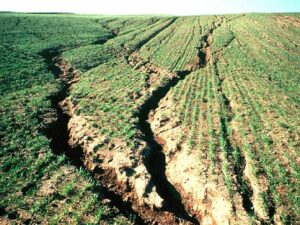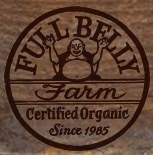
Agriculture Dictionary A vivid and detailed medium shot illustration of direct marketing in agriculture. The medium shot shows a farmer standing at a market stall filled wit2.webp.webp
Definition: Direct Marketing
Direct marketing in agriculture involves selling farm products directly to consumers without intermediaries. This can include various methods such as farmer’s markets, Community-Supported Agriculture (CSA), on-farm sales, online sales, and direct-to-retail or restaurant sales. The goal is to create a direct connection between the farmer and the consumer, ensuring better prices for farmers and fresh, high-quality products for consumers.
Understanding Direct Marketing
Introduction
Direct marketing offers farmers the opportunity to establish a closer relationship with consumers, control the pricing of their products, and receive immediate feedback. By eliminating the middlemen, farmers can retain a larger portion of the sales price and enhance their economic viability. Consumers benefit from access to fresher, locally grown produce and a better understanding of where their food comes from.
Fall off the barn roof and busted your keister? Life on the farm or ranch can be tough on the bum. Need a break? Laugh it off at FarmerCowboy.com, the #1 farm humor site. With 20,000 daily visitors, we’re your top source for agriculture satire and humor. Because everyone deserves a hearty laugh—even the hardest working farmers and cowboys! Join us and turn those long days into fun tales at FarmerCowboy.com.
Types of Direct Marketing
1. Farmer’s Markets
Farmer’s markets are community-based events where farmers sell their products directly to consumers. These markets often take place weekly or bi-weekly and offer a wide variety of fresh, seasonal produce, meats, dairy products, baked goods, and artisan items.
2. Community-Supported Agriculture (CSA)
CSA programs involve consumers purchasing shares of a farm’s harvest in advance. Members receive regular deliveries of fresh produce and other farm products throughout the growing season. This model provides farmers with upfront capital and a guaranteed market.
3. On-Farm Sales
On-farm sales include farm stands, U-pick operations, and farm stores where consumers visit the farm to purchase products directly. This approach allows farmers to showcase their operations and engage with customers in a unique setting.
4. Online Sales
Farmers can sell their products through online platforms, including their own websites, social media, and third-party marketplaces. Online sales can reach a broader audience and offer convenience for both farmers and consumers.
5. Direct-to-Retail or Restaurant Sales
Farmers may establish direct relationships with local retailers, grocery stores, and restaurants to supply them with fresh products. These partnerships can provide a consistent market and strengthen community ties.
Benefits of Direct Marketing
Higher Profit Margins
By selling directly to consumers, farmers can capture a larger portion of the retail price. This increased profitability can make farming more sustainable and economically viable.
Consumer Relationships
Direct marketing fosters a personal connection between farmers and consumers. This relationship can lead to increased customer loyalty, repeat business, and valuable feedback on products.
Market Diversification
Engaging in direct marketing allows farmers to diversify their income streams and reduce dependency on wholesale markets. This diversification can provide greater financial stability and resilience.
Product Control
Farmers have more control over the pricing, quality, and marketing of their products. This control allows them to differentiate their products and build a unique brand identity.
Community Engagement
Direct marketing enhances community engagement by bringing people together around local food. It supports local economies, reduces food miles, and promotes sustainable agricultural practices.
Challenges of Direct Marketing
Time and Labor Intensive
Direct marketing requires significant time and labor for activities such as attending markets, managing online sales, and building customer relationships. This can be challenging for farmers with limited resources.
Market Access
Accessing and establishing a presence in direct markets can be difficult, especially for new or small-scale farmers. Competition and market saturation can also pose challenges.
Logistics and Infrastructure
Managing the logistics of direct sales, including transportation, storage, and packaging, requires careful planning and investment. Farmers need adequate infrastructure to handle these aspects efficiently.
Regulatory Compliance
Direct marketing involves complying with various regulations related to food safety, labeling, and certification. Navigating these regulatory requirements can be complex and time-consuming.
Steps to Successful Direct Marketing
1. Assess Market Opportunities
Conduct market research to identify potential opportunities and demand for direct marketing in your area. Understand consumer preferences, competition, and local regulations.
2. Develop a Marketing Plan
Create a detailed marketing plan that outlines your goals, target audience, marketing strategies, and budget. This plan will guide your efforts and help measure progress.
3. Build Relationships
Focus on building strong relationships with your customers, local retailers, and community organizations. Engage with your audience through social media, newsletters, and events to keep them informed and connected.
4. Ensure Product Quality
Maintaining high product quality is crucial for building a loyal customer base. Invest in best practices for growing, harvesting, and handling your products to ensure they meet consumer expectations.
5. Utilize Technology
Leverage technology to streamline your operations and reach a broader audience. Use online sales platforms, social media, and digital marketing tools to promote your products and manage sales.
Case Studies of Successful Direct Marketing
1. The Farmer’s Dog (New York, NY)
The Farmer’s Dog started as a direct-to-consumer fresh pet food company. By focusing on high-quality ingredients and personalized service, they built a loyal customer base and expanded their reach through online sales and home delivery.
2. Polyface Farm (Swoope, VA)
Polyface Farm uses direct marketing to sell pasture-raised meat and eggs. They have built a strong brand based on sustainable farming practices and direct sales through their farm store, farmer’s markets, and online platform.
3. Greenmarket Co. (New York, NY)
Greenmarket Co. is a wholesale distribution service operated by GrowNYC, which connects regional farmers with local retailers, restaurants, and institutions. This model provides farmers with a consistent market while promoting local, sustainable food systems.
Conclusion
Direct marketing is a powerful strategy for farmers to enhance their economic viability, build customer relationships, and promote sustainable agriculture. By selling directly to consumers, farmers can capture higher profit margins, gain valuable market insights, and foster community engagement. Despite challenges such as time commitment and regulatory compliance, successful direct marketing can significantly benefit both farmers and consumers.
How Knowledge of Direct Marketing Can Help Farmers
Understanding direct marketing can help farmers develop effective strategies to reach consumers and build profitable, sustainable businesses. By leveraging direct marketing methods, farmers can increase their revenue, diversify their income streams, and create strong connections with their local communities. This knowledge empowers farmers to navigate the complexities of the market, enhance their product offerings, and achieve long-term success.

Originally posted 2024-05-26 03:23:40.
Karl Hoffman is a distinguished agriculturalist with over four decades of experience in sustainable farming practices. He holds a Ph.D. in Agronomy from Cornell University and has made significant contributions as a professor at Iowa State University. Hoffman’s groundbreaking research on integrated pest management and soil health has revolutionized modern agriculture. As a respected farm journalist, his column “Field Notes with Karl Hoffman” and his blog “The Modern Farmer” provide insightful, practical advice to a global audience. Hoffman’s work with the USDA and the United Nations FAO has enhanced food security worldwide. His awards include the USDA’s Distinguished Service Award and the World Food Prize, reflecting his profound impact on agriculture and sustainability.



